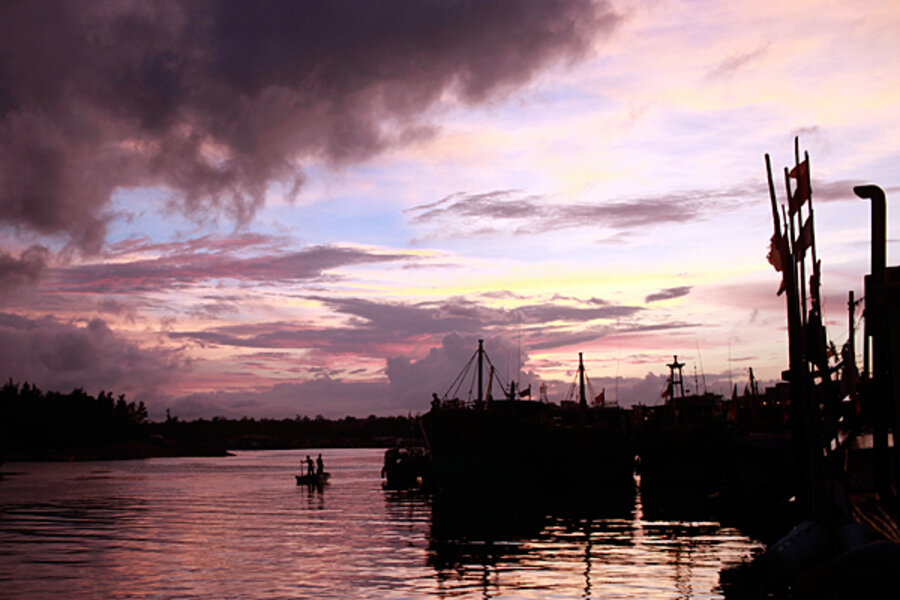Why won't China sign the South China Sea code of conduct?
Loading...
| Taipei, Taiwan
Here they go again. Asian governments with overlapping claims to the South China Sea are working this week toward a code of conduct for handling the frequent upsets between competing naval ships.
The agreement, raised at the Association of South East Asian Nations in Cambodia, would be the 10th covering essentially the same territorial dispute since the 1982 United Nations Convention on the Law of the Sea. The idea is that it would spell out what ships should do to avoid a clash but it wouldn't actually spell out how to resolve competing claims, according to regional news media.
So what’s the big deal behind this year’s deal – besides calming nervous people onshore and making their leaders look like saintly peacemakers?
The deal doesn't really work unless China, the one that all the others are worried about, agrees to it. But China is leaning against adding its signature. It wants to keep an upper hand in the dispute, especially with the recent US push to focus on Asia.
“China says there needs to be greater confidence and trust building – there’s a sense that China is being told what to do,” says Bonnie Glaser, senior fellow with the think tank Center for Strategic and International Studies in Washington. “The risk is, it becomes a voluntary agreement, and in that case, it's completely meaningless,” she adds.
Safety net against China?
Naval ships often track their countries’ oil rigs and fishing expeditions. Oil, natural gas, and fish explain why the 3.5 million square kilometers (1.4 million square miles) of water stretching from Singapore to Taiwan are so sought after.
The past three decades have seen countless military clashes: One occurred in 1976, when China took the tiny, uninhabited Paracel Islands from Vietnam. Another came in 1988, when China and Vietnam clashed in the equally miniscule Spratly Islands, according to the US-based public policy organization GlobalSecurity.org. The 1988 incident sank Vietnamese boats and killed 70.
So agreements are popular between the smaller claimants that, in addition to Vietnam, include Brunei, Malaysia, Taiwan, and the Philippines. They want a safety net against China, which is ranked No. 3 in the world in terms of military might.
A 1999 regional code of conduct largely written by the Philippines was directed at containing China. In April this year, vessels from China and the Philippines were locked in a standoff over Scarborough Shoal, a South China Sea landmark west of Luzon Island.
China's take
China dodged signing the code of conduct this week at the East Asia Summit, a regional security meeting in Cambodia. But, Beijing's language on the issues in the South China Sea has swung from bristly to conciliatory.
“China is using both hands, soft and hard, yet the hard hand would never come to military action,” says Lin Chong-pin, strategic studies professor at Tamkang University in Taiwan. “But code of conduct – has China agreed? Of course not.”
China is torn between being a good Asian neighbor but using its dominant role in the region to get the most out of the ocean instead of conceding rights to a group of rivals, analysts deduce. “[China] is a much bigger country and can leverage that better in its bilateral agreements,” Ms. Glaser says.
The code being discussed now would include the whole 10-nation Association of Southeast Asian Nations bloc.
China also must mind Washington or risk that the No.1 military power will side with the smaller claimants.
US Secretary of State Hillary Clinton irked China this week by urging it to settle the dispute with all parties. Washington is technically neutral, but relies on the sea for shipping lanes that see about half the world’s tanker traffic.
If the United States got involved now, it may err on the side of aggression. US President Obama wants to be seen as a strong leader before his reelection bid in November, Mr. Lin says. “He has to do things that the Republicans cannot use as ammo against him,” he says.





